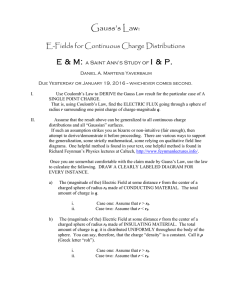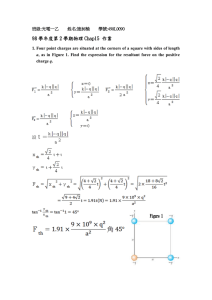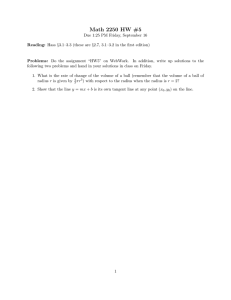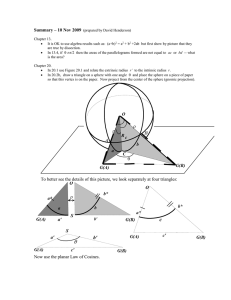Electrostatics - Cloudfront.net
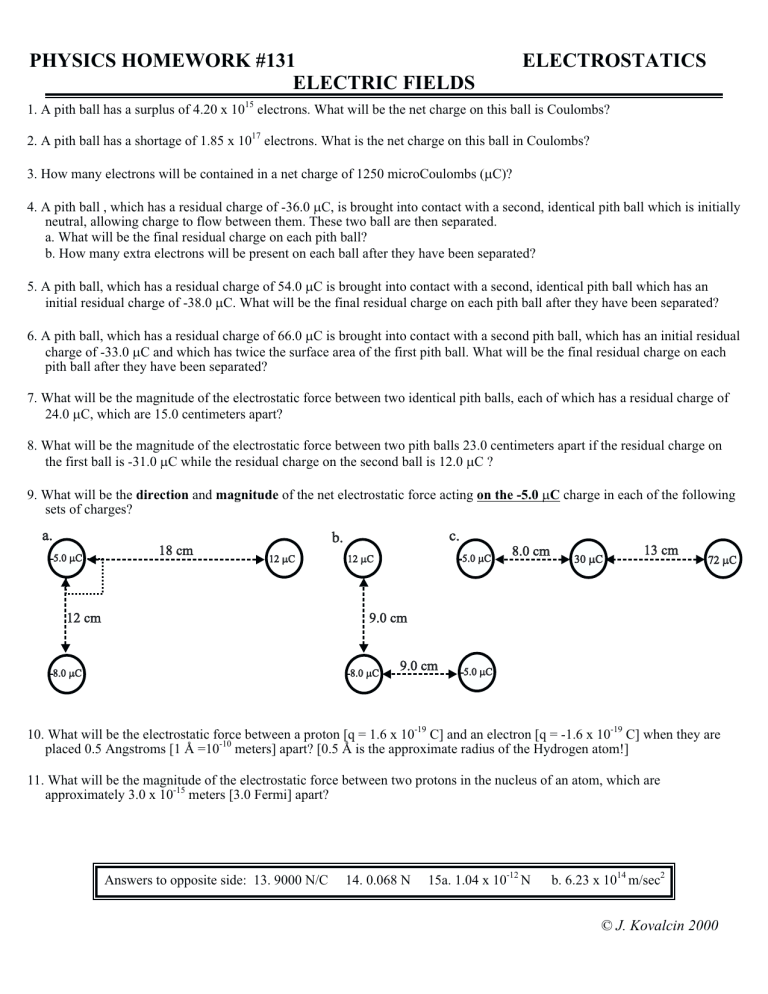
PHYSICS HOMEWORK #131
ELECTRIC FIELDS
1. A pith ball has a surplus of 4.20 x 10 15
ELECTROSTATICS
electrons. What will be the net charge on this ball is Coulombs?
2. A pith ball has a shortage of 1.85 x 10 17 electrons. What is the net charge on this ball in Coulombs?
3. How many electrons will be contained in a net charge of 1250 microCoulombs ( m C)?
4. A pith ball , which has a residual charge of -36.0
m C, is brought into contact with a second, identical pith ball which is initially neutral, allowing charge to flow between them. These two ball are then separated.
a. What will be the final residual charge on each pith ball?
b. How many extra electrons will be present on each ball after they have been separated?
5. A pith ball, which has a residual charge of 54.0
m C is brought into contact with a second, identical pith ball which has an initial residual charge of -38.0
m C. What will be the final residual charge on each pith ball after they have been separated?
6. A pith ball, which has a residual charge of 66.0
m C is brought into contact with a second pith ball, which has an initial residual charge of -33.0
m C and which has twice the surface area of the first pith ball. What will be the final residual charge on each pith ball after they have been separated?
7. What will be the magnitude of the electrostatic force between two identical pith balls, each of which has a residual charge of
24.0
m C, which are 15.0 centimeters apart?
8. What will be the magnitude of the electrostatic force between two pith balls 23.0 centimeters apart if the residual charge on the first ball is -31.0
m C while the residual charge on the second ball is 12.0
m C ?
9. What will be the direction and magnitude of the net electrostatic force acting on the -5.0
m C charge in each of the following sets of charges?
10. What will be the electrostatic force between a proton [q = 1.6 x 10 placed 0.5 Angstroms [1 Å =10 -10
-19 C] and an electron [q = -1.6 x 10 -19 meters] apart? [0.5 Å is the approximate radius of the Hydrogen atom!]
C] when they are
11. What will be the magnitude of the electrostatic force between two protons in the nucleus of an atom, which are approximately 3.0 x 10 meters [3.0 Fermi] apart?
Answers to opposite side: 13. 9000 N/C 14. 0.068 N 15a. 1.04 x 10 -12 N b. 6.23 x 10 14 m/sec 2
© J. Kovalcin 2000
PHYSICS HOMEWORK #132
ELECTRIC FIELDS
ELECTROSTATICS
12. Sketch the electric field for each of the following arrangements of charge. Use at least 8 field lines for each diagram, indicate the directions of the field lines with arrows pointing in the appropriate directions. [The field lines should always point away from the positive charges and towards the negative and the number of field lines leaving or converging on a charge should be directly proportional to the intensity of the charge!]
13. What will be the strength of the electric field at a point in space where a 5.00
m C charge feels an electrostatic force of
F = 0.045 Newtons?
14. A charge of 8.5
m C is placed in a uniform electric field which has an intensity of E = 8,000 N/C. What will be the magnitude of the resulting force?
15. A proton [q = 1.6 x 10 -19 C and mp = 1.67 x 10 -27 kg] is placed in a uniform electric field which has an intensity of
E = 650,000 N/C.
a. What will be the magnitude of the resulting electrostatic force?
b. What will be the resulting acceleration of the proton as a result of this field?
Answers to opposite side: 1. 670 m C 2. 29,600 m C 3. 7.80 x 10
5. 8.0.0
m C 6. 22.0
m C & 11.0
m C 7. 230 N 8. 63.3 N 9a. 30.6 N at 56
9c. 284 N East 10. -9.2 x 10 -8 N 11. 25.6 N
15 e4a. -18.0
m C b. 1.125 x 10 14 o NE b. 31.5 N at 49 o e-
NE
© J. Kovalcin 2000
PHYSICS HOMEWORK #133 ELECTROSTATICS
CALCULATING THE ELECTRIC FIELD
16. What will be the electric field strength 45.0 cm from a pith ball which has a residual charge of 5.5
m C?
17. What will be the electric field strength a distance of 2450 Å from the nucleus of a Helium atom? a Carbon atom?
where
18. A small pith ball, which has a mass of 0.056 grams and contains a residual charge of 5.0
m C, is sitting in a vertically oriented electric field as shown at the right, such that the force of gravity acting downward on this ball is exactly balanced by the electric field directed upward.
a. What will be the gravitational force acting on the pith ball?
b. What will be the magnitude of the electrostatic force acting on the pith ball?
c. What is the magnitude of the electric field that is supporting this ball?
19. What will be the magnitude and direction of the electric field at point x in each of the following diagrams?
k
=
.
×
9
×
Nm 2
C 2
20. A pith ball, which has a mass of 2.2 gm and which contains a residual charge of 1.3
m C, is placed in a uniform electric field, which has a magnitude of E = 85,000 N/C and which is directed upward, as shown below. Assume that the pith ball is initially suspended [neither rising or falling].
a. What will be the magnitude of the gravitational force acting on this pith ball?
b. What will be the magnitude of the electrostatic force acting on this pith ball?
c. What will be the direction of the net force acting on this pith ball?
d. What will be the magnitude of the net force acting on this pith ball?
e. What will be the magnitude and direction of the resulting acceleration of this pith ball?
f. What will be the displacement of this pith ball after 0.5 seconds?
g, What will be the velocity of the pith ball after 0.5 seconds?
ANSWERS TO THE OPPOSITE SIDE: 21a. -1.64 x 10
21d. 5.4 x 10 13 m/s 2
22d. at x = 35 cm & y = 9.3 cm e. 6.56 x 10
23d. 7.7 nC, 23.1 nC j e. 6.8 x 10 7 m/s at 85 o
7
NE f. 42.5 m at 81 o m/s at 28 o
-26 N j b. 8.96 x 10
23a. 3.65 x 10 -4
-14 N j c. 8.96 x 10
NE 22b. 4.64 x 10 -15
N b. 0.0133
m
-14 N j
N c. 6.03 x 10
C c. 8.33 x 10 10
-9 es
© J. Kovalcin 2000
PHYSICS HOMEWORK #134 ELECTROSTATICS
ELECTRIC FORCES IN UNIFORM FIELDS
21. A proton, which has a mass of 1.67 x 10 with a velocity of 5.6 x 10 6
-27 kg and a charge of 1.6 x 10 -19 C, is moving m/s from left to right into a uniform electric field as shown in the diagram to the right. The electric field has a magnitude of 560,000 N/C and is directed upward.
a. What will be the direction and magnitude of the gravitational force acting on this proton?
b. What will be the direction and magnitude of the electrostatic force acting on this proton?
c. What will be the direction and magnitude of the net force acting on the proton?
d. What will be the direction and magnitude of the acceleration of this proton?
e. What will be the velocity of this proton 1.25 microseconds after entering the electric field?
f. What will be the displacement of this proton 1.25 microseconds after entering the electric field?
22. An electron, which has a mass of 9.11 x 10 -31 kg and a charge of -1.6 x 10 enters a uniform electric field with a velocity of 5.8 x 10 7
-19 m/s. The electric field has a magnitude of 29,000 N/C, is pointing vertically downward and is contained within a limited area as shown to the right.
a. Sketch the path of this particle through the electric field.
b. What will be the net force acting on this electron?
c. How long will it take for this electron to pass through this field?
d. Where, exactly, will the electron exit the field?
e. What will be the velocity of the electron as it exits the field?
C,
23. Two pith balls, each of which is suspended from the end of a piece of very thin thread, are attached to a common point of suspension as shown to the left. Each pith ball has a mass of
0.13 gm and each piece of thread is L = 12.0 cm long. Each of the two pith balls is given a net charge and as a result the two balls repel one another until the angle between the two balls increases to q = 32o.
a. What will be the magnitude of the electrostatic force between these two balls?
b. Determine the magnitude of the charge on each ball if the charge is distributed evenly between the two balls.
c. Assuming that this charge is negative, how many excess electrons would be found on each ball?
d. Determine the charge on each ball if the charge of q1 is 3x the charge q2.
e. Experimentally, how could you determine if the pith balls were charged positive or negative?
Answers to opposite side: 16. 2.4 x 10 5
18b. 5.5 x 10 -4
18d. 6.01 x 10 6
N c. 110 N/C
N/C at 56.3
o
20c. upward d. 8.89 x 10
SW
-2 N
N/C e. 1.10 x 10 e. 40.4 m/s 2
7
17. 4.8 x 10
19a. -4.54 x 10 7
4
SE
N/C, 1.44 x 10 5
N/C I b. 3.73 x 10
N/C at 80 o
7
N/C 18a. -5.5 x 10
N/C I c. 2.96 x 10
20a. 2.16 x 10 -2 upward f. 5.05 m g. 20.2 m/s
6
-4
N b. 1.11 x 10 -1
N
N/C at 76.7
N o SW
© J. Kovalcin 2000
PHYSICS HOMEWORK #135 ELECTROSTATICS
CALCULATING THE ELECTRIC FIELD - GAUSS’S LAW
1. A charge of Q = +25.0
m C is distributed evenly on the surface of a conducting sphere, which has a radius of R = 5.0 cm; a. What will be the charge density [s] on this surface?
b. What should be the shape of a Gaussian surface such that all points on this surface have the same electric field strength and so that the electric field is perpendicular to all points on the surface? Why are these conditions desirable?
c. What will be the electric field strength 3.0 cm from the center of this sphere?
d. Using Gauss’s Law develop an expression which will predict the electric field strength for any point outside this sphere. [r >R] e. What will be the electric field strength 7.0 cm from the center of this sphere?
f. On the diagram to the right sketch the electric field in the vicinity of this charged sphere.
g. On the graph below sketch the electric field strength as a function of distance from the center of the sphere.
ò
E dA 4
p
k q enclosed
2. A charge of Q = +45.0
m C is distributed uniformly across the surface of an insulating plane [the thickness is insignificant] which is 35.0 cm wide and 55.0 cm high; a. What will be the surface charge density s on this plane?
b. What should be the shape of a Gaussian surface such that all points on this surface have the same electric field strength and so that the electric field is perpendicular to all points on the surface? Explain!
c. Using Gauss’s Law develop an expression predicting the electric field strength as a function of distance from this finite plane.
d. What will be the electric field strength R = 2.00 cm from the center of this finite plane?
e. What will be the electric field strength R = 5.00 cm from the center of this plane?
f. In general, how does the electric field strength vary with increasing distance from a uniform, planar distribution of charge?
g. What will be the electric field strength 2,550 meters from the center of this plane?
h. Why is the answer to g different from the answer to d ? Explain!
3. A charge of -15.0
m C is distributed evenly along a conducting wire which is 70.0 cm long; a. What will be the charge density l along this wire?
b. Using Gauss’s Law, develop an expression predicting the electric field strength as a function of distance from the charged wire.
c. What will be the strength of the electric field R = 2.00 cm from the center of this wire?
d. In general, how does the electric field strength vary with distance from a charged, straight wire? Explain!
e. What will be the electric field strength 1250 meters from the center of this wire?
f. Why is the answer to e different from c ? Explain!
g. What general statement can you make about the electric field strength very far away from any FINITE charged body?
Explain!
Answers to opposite side: 4a. 1.04 x 10
4e.
4 /
3 p k r
C/m 3 b. sphere c.
N/C g. q = Q h. +15 m C i. kQ/r
5b. cylinder c.
p r2L r d. -8.7 x 10
5j. 6.3 x 10 r f. 1.57 x 10
6 N/C
7
-7
-2
2
4 /
3 p r 3 r d. 1.17 x 10 -6 j. 8.0 x 10 6 N/C 5a. -1.11 x 10
C e. q = Q f. -3.5
m C g. 2 p kr r h. 6.28 x 10 6
C
-2 C/m
N/C i. 2kQ/Lr
3
© J. Kovalcin 2000
PHYSICS HOMEWORK #136 ELECTROSTATICS
CALCULATING THE ELECTRIC FIELD - GAUSS’S LAW
4. A solid, insulating sphere, which has a radius of R = 7.0 cm, contains Q = +15 m C of charge distributed uniformly throughout its interior.
a. What will be the charge density r contained within this sphere?
b. What should be the shape of a Gaussian surface such that all points on this surface have the same electric field strength and so that the electric field is perpendicular to all points on the surface?
c. Develop an expression for the charge contained within any Gaussian surface for which the radius of the Gaussian surface r is less than the radius of the solid sphere. [i.e. r <R] d. How much charge will be contained within a Gaussian surface which has a radius of r
= 3.00 cm?
e. Using Gauss’s Law develop an expression for the electric field strength anywhere within this solid sphere.
f. What will be the electric field strength r = 4.00 cm from the center of this solid sphere?
g. Develop an expression for the total charge contained within any Gaussian surface where the radius of the Gaussian surface r is greater than the radius of the solid sphere R .
h. How much charge will be contained within a Gaussian surface which has a radius of r = 13.0 cm?
i. Develop an expression describing the electric field strength anywhere outside this solid sphere. [i.e. r >R] j. What will be the electric field strength r = 13.0 cm from the center of this solid sphere?
k. On the graph at the right sketch the electric field strength as a function of distance from the center of the solid sphere.
5. Consider an insulating cylinder, which is L = 25.0 cm long, has a radius of R = 2.0 cm. and contains Q = -3.5 mC of charge distributed uniformly throughout its interior.
a. What will be the charge density r contained within this cylinder?
b. What should be the shape of the Gaussian surface for this solid cylinder so that the electric field strength is uniform at all points on the Gaussian surface and such that the electric field is perpendicular to all points on the Gaussian surface?
c. Develop an expression describing the charge contained within a Gaussian surface which has a radius r that is less that the radius R of the cylinder.
d. How much charge will be contained within a Gaussian surface which has a radius of r = 1.00 cm?
e. Develop an expression which will predict the charge contained within a Gaussian surface which has a radius r that is greater that the radius R of the solid cylinder.
f. How much charge will be contained within a Gaussian surface which has a radius of r = 4.00 cm?
g. Develop an expression which will predict the electric field strength as a function of distance from the center of the solid cylinder for distances r less that the radius R of the cylinder.
h. What will be the electric field strength r = 1.00 cm from the center of this cylinder?
i. Develop an expression describing the electric field strength for points outside of the solid cylinder. [r > R] j. What will be the electric field strength r = 4.00 cm from the center of the solid cylinder?
k. On the graph at the right plot the electric field as a function of distance from the center of the cylinder.
Answers to opposite side: 1a. 7.96 x 10 -4
2a. 2.34 x 10 -4
2g. far away a finite plane looks like a point. 3a. 2.14 x 10 -5
3e. 8.64 x 10 -2
C/m 2
C/m 2 b. sphere b. “tin can” c. 2 p k s d. 1.32 x 10 7 c. zero d. kQ/r 2 e. 4.59 x 10 7 N/C
N/C e. same as d f. E = constant
C/m b. 2kQ/Lr c. 1.93 x 10 7 N/C d. inversely
N/C f. far away a finite line looks like a point.
g. far enough away any finite object looks like a point!
© J. Kovalcin 2000
PHYSICS HOMEWORK #137 ELECTROSTATICS
CALCULATING THE ELECTRIC FIELD - GAUSS’S LAW
6. Consider a conducting spherical shell, which has an inner radius of R
1 outer radius of R
2
= 9.00 cm and contains a charge of Q
2 turn, encloses a point charge of Q
1
= -6.00
m
= +18.0
m
= 7.00 cm, an
C. This shell, in
C located at its center, as shown in the diagram at the right.
a. Using Gauss’s Law develop an expression which will predict the electric field
] and evaluate that expression strength inside the spherical shell [for values of r <R
1 for a value of r = 5.00 cm.
b. Using Gauss’s Law develop an expression which will predict the electric field strength within the spherical shell and evaluate that expression for a point r = 8.00
cm from the center of the shell.
c. Using Gauss’s Law develop an expression which will predict the electric field strength outside of the spherical shell and evaluate that expression for a value of r = 12.0 cm.
d. What will be the charge density on the inner surface of the spherical shell?
e. What will be the charge density on the outer surface of the spherical shell?
f. On the diagram to the right sketch the electric field [lines of force] everywhere.
g. On the graph to the right sketch the electric field strength as a function of distance from the center of the spherical shell.
7. An insulating, solid sphere has a radius of R
1
= 3.50 cm and contains a charge of 55.0
m C which is distributed uniformly throughout its volume. This sphere is in turn surrounded by an uncharged, conducting spherical shell, which has an inner radius of R
2
= 6.50 cm and an outer radius of R = 8.00 cm.
a. Using Gauss’s Law develop an expression which will predict the electric field strength everywhere inside of the solid sphere and evaluate that expression for a value of r = 1.0
cm. [r <R
1
] b. Using Gauss’s Law develop an expression which will predict the electric field strength outside of the solid sphere but inside the spherical shell and evaluate that expression for a value of r = 4.00 cm. [R
1
<r <R
2
] c. What will be the electric field strength within the spherical shell? Justify! [R
2
<r < R
3
] d. Using Gauss’s Law develop an expression which will predict the electric field strength everywhere outside of the spherical shell and evaluate that expression for a value of r =
10.5 cm. [r >R
3
] e. What will be the surface charge density s
2 f. What will be the surface charge density s
3 on the inner surface of the spherical shell?
on the outer surface of the spherical shell?
Suppose, instead, that the insulating,charged sphere has a charge density which varies as a function of distance from the center of the sphere according to the relationship r =( 4.17 x 10 4 g. What will be the total charge Q
1
+ 1.91 x 10 of this insulating, charged sphere?
h. What will be the strength of the electric field r = 2.0 cm from the center of this insulating sphere?
i. What will be the strength of the electric field r = 5.0 cm from the center of the insulating sphere?
7 r 2 ) m C/m 3
Answers to opposite side: 8a. 7.07 x 10
9a. -3.37 x 10 f. -5.13 x 10
2k( l + r [R
3
2
7
-R
7
2
2
N/C j b. 1.81 x 10 7
4 N/C i b. 2.12 x 10 5
N/C j c. -1.51 x 10 7
N/C j g. zero h. 1.34 x 10
])/r for [R
2
<r <R
3
], 2k( l
1
+
-4 l
2
C/m 2 , 4.54 x 10
)/r for [r >R
-4
N/C c. -7.07 x 10
N/C j d. -2.42 x 10
C/m 2
3
] c. 3.87 x 10 6 N/C
-12
4 N/C i
N j e. 5.13 x 10
10a. zero for [r <R
1
7 N/C j
], 2k l /r for [R
1
<r <R
2
],
© J. Kovalcin 2000
PHYSICS HOMEWORK #138 ELECTROSTATICS
CALCULATING THE ELECTRIC FIELD - GAUSS’S LAW
8. Consider two vertically oriented, parallel infinite planes. The left hand plane has a charge density of m C/m 2
1
. The two planes are d = 5.0 cm apart as shown to the right.
at point P
2 s
.
c. Using Gauss’s Law, determine the electric field strength to the right of the two planes at point P
3
.
while the right hand plane has a charge density of s
2
= -2.50
a. Using Gauss’s Law, determine the electric field strength to the left of the two planes
1
.
= 1.25
m C/m 2 b. Using Gauss’s Law, determine the electric field strength between the two planes at point P
9. Consider two horizontally oriented, parallel planes as shown below. Each plane has a width of w = 25 cm and a depth of d = 15 cm. The upper plane is a conductor which has a thickness of t = 1.0 cm, while the lower plate is an insulator of negligible thickness.
These two plates are a distance of x = 5.0 cm apart. A total charge of Q placed on the upper plate, while a total charge of Q
2
1
= 22 m C is
= +12 m C is placed on the lower plate.
a. What will be the direction and magnitude of the electric field between these two planes as caused by the upper plane?
b. What will be the direction and magnitude of the electric field between these two planes as caused by the lower plane?
c. What will be the direction and magnitude of the electric field between these two planes as caused by both planes?
g. What will be the direction and magnitude of the electric field within the upper plate?
h. What will be the charge densities s
1 and s
1 d. What will be the direction and magnitude of the electrostatic force acting on a proton placed in the area between these two plates?
e. What will be the direction and magnitude of the electric field in the area above these two planes?
f. What will be the direction and magnitude of the electric field in the area below these two planes?
’ on the upper and lower surfaces of the upper plate?
i. Make a sketch showing the electric field everywhere in the vicinity of these plates.
10. Consider a conducting cylinder which has a radius of R charge density of l
1 cylindrical shell which has an inner radius of R
2
1
= .05 cm and which contains a
= +2.2
m C/m of length and which is surrounded by an insulating
= 1.5 cm and an outer radius of R
3
=
2.25 cm. This outer cylinder has charge distributed uniformly throughout with a charge density of r
2
= +747 m C/m 3 .
a. Develop the set of expressions that will predict the electric field everywhere in the area of these two cylinders.
b. Make a graph showing the electric field strength as a function of distance from the center of the cylinders.
c. What will be the electric field strength 2.0 cm from the center of the cylinders.
Answers to opposite side: 6a. 2.16 x 10
6e. 1.18 x 10
7f. 6.84 x 10
-4
-4
C/m
C/m 2
2 7a. 1.15 x 10 8
7 N/C b. zero c. 7.5 x 10
N/C b. 3.09 x 10 8 g. 10.0
m C h. 3.49 x 10 7 N/C
6 N/C d. 9.74 x 10
N/C c. zero d. 4.49 x 10 i. 2.25 x 10 8 N/C
7
-5 C/m 2
N/C e. -1.04 x 10 -3 C/m 2
© J. Kovalcin 2000
© J. Kovalcin 2000
PHYSICS HOMEWORK #140
MAGNETIC FORCE ON MOVING CHARGES
ELECTROSTATICS
© J. Kovalcin 2000
